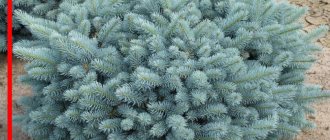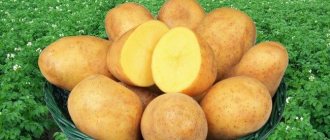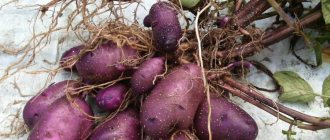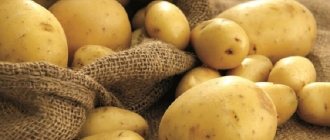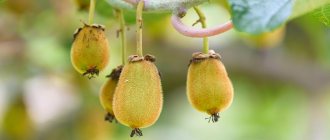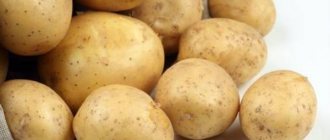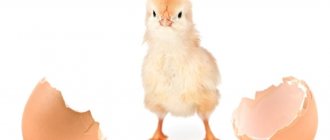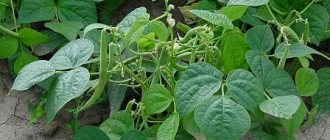Appearance and distribution
The “kiwi” potato got its name for its external resemblance to the famous fruit; it is considered a product of genetic engineering and genetically modified, but this opinion is erroneous. And it does not pose any danger to the body. On the contrary, it is very profitable.
This variety has already been tested in Belarus, Lithuania, Kazakhstan, Ukraine, and is actively grown in the Krasnodar region, Kaluga, Moscow, Nizhny Novgorod, Yaroslavl, Perm, Volgograd, Ivanovo regions, and in the Krasnodar region.
Some farmers believe that the kiwi potato originated in Belarus. But this is a mistake, “kiwi” was created by Russian breeders in the Kaluga region.
Diseases and pests
The Kiwi potato variety is resistant to the Colorado potato beetle. The pest does not eat shoots. Insects are repelled by the rough surface of the leaves. It is impossible to lay eggs and hatch larvae on such hairy leaves.
Therefore, pests move to the simplest potato varieties that have a glossy leaf surface. The variety is not affected by wireworm. The subspecies has biofiber in its structure.
Pests cannot digest such material. The subspecies is highly resistant to viruses and infections. Not affected by late blight, cancer, alternaria, fomoz, scab, rot, rhizoctonia, fusarium and verticillium wilt.
The Kiwi potato variety has received positive reviews from gardeners. Resistant to viruses, diseases and pests. Responds well to fertilizing. It is a high-yielding subspecies. Has excellent keeping quality .
Stores in cool vegetable stores until next year. Belongs to rare varieties.
Description and characteristics
Kiwi potatoes have very tall bushes, depending on the soil, they can grow up to 80 cm. Straight stem, with emerald leaves, which have a jagged edge, lilac inflorescences. Its flowers often attract bees.
Characteristic:
- To the touch, the fruits are elongated, with round edges, and rough due to small hairs.
- Mesh peel.
- The pulp is snow-white-yellow and boils well. The only negative is that the cooking process is much longer than with a regular vegetable, it takes at least 40 minutes. Can be used for purees and soups.
- Well kept. If you create the right conditions, it will lie quietly for at least a year without losing its taste.
- Lush lilac inflorescences.
Features of kiwi potatoes:
- Grows on all types of soil, best on sandy loam.
- The taste is mild.
- Very resistant to plant diseases and pests.
- Loves a lot of sun, systematic watering.
- Takes all feedings well.
- Rich in yield, you can actually “remove” up to 20 kg from a kilogram of potatoes.
- Grows in all regions.
A very rare variety, the price per kilogram reaches up to 100 rubles.
Description of the variety
Many varieties of amateur selection are grown on the plots of summer residents, and Kiwi potatoes are one of them. Brought out at the end of the last century in the Kaluga region, the main cultivation region is central Russia, as well as the North-West, Krasnodar Territory.
The unpretentious species has successfully taken root in vegetable gardens due to its unique properties. It got its name because of its resemblance to an exotic fruit, since the skin on the tubers is velvety and brown. The Kiwi potato is avoided by the Colorado potato beetle; it is not afraid of late blight, scab and a number of other traditional crop diseases.
Seed selection
Experts advise selecting potatoes for planting in the summer, when flowering is in progress, then it is easy to mark the lushest and healthiest bushes. This guarantees good heredity, and the tubers under such bushes are more stable.
Selection rules:
- They take tubers from bushes where at least 7-8 have grown.
- The weight of the potatoes should be at least 100 g, since they dry out a little during the winter.
- The selected material should be left in the sun for a couple of hours to dry and clear of soil.
Tips for caring for potatoes
Due to its unusual origin, Kiwi potatoes do not require additional chemical treatments. Therefore, the variety is primarily suitable for lovers of environmentally friendly products.
Watering and fertilizing
The plant does not require irrigation procedures. During the entire growing and ripening season, potatoes are watered no more than 3-4 times.
When watering, the soil is thoroughly moistened to a depth of up to half a meter.
To get a large harvest, potatoes are fed with mineral fertilizers. During the season, 3 feeding procedures are required. The first time it is held at the end of the spring period. The remaining fertilizing is applied according to the schedule once every 10 days.
See also
Review of the best models of cultivators for inter-row tillage, how to do it yourself
Read
Loosening and weeding
Weed control begins before planting vegetables in the ground. Next, the weeds are removed as needed. Before planting tubers, work is carried out to thoroughly loosen the soil. If the site has heavy soil, loosening is carried out after watering. The main thing is that a dense crust does not form on the surface of the earth, which prevents oxygen from reaching the rhizomes.
Hilling
Hilling up work is carried out after heavy watering or rain. Soil is raked out from the row spacing and added under the plant. The hilling procedure is necessary for this variety 2 times during the entire growth period. The first time this procedure occurs is in June, and the second time before the start of the flowering period.
Storage of seed potatoes
Basic Rules:
- For the peel to ripen, it needs to lie down for 2 weeks, at 18-20 degrees Celsius, in a room with good ventilation.
- The potatoes are placed in a 10 cm layer and turned over from time to time to turn green.
- After half a month, select the bad tubers and put them in storage. This could be a cellar, with a humidity of at least 70%, or an apartment. At home, it is convenient to keep seed potatoes on the balcony, in a special heated box. If there is no severe frost, it can be stored in canvas bags or nets.
- You need to sort through potatoes at least 3 times during the winter.
The main pros and cons of the variety
The Kiwi vegetable crop was created as an improved potato variety, so it has many advantages:
- Does not require special skills in growing and caring.
- High rates of disease resistance.
- The variety is immune to various pests.
- Long-term storage of ripened tubers.
- Good yield. Up to 5 kg of potatoes are harvested from one bush.
Flaws:
- Later, long ripening. It takes 130 days after planting the planting material in open ground.
- The long process of preparing ripened tubers. Boiling potatoes takes 40-50 minutes.
- Lack of pronounced taste and aroma in tubers.
- Planting materials are rare, so their prices are high.
Kiwi potatoes are considered a universal variety, but due to the dense structure of the root vegetables, the cooking time is long, so frying the vegetable is not recommended.
See also
Description and characteristics of the Lugovskoy potato variety
Read
Seed preparation
To get a good harvest, you need to carefully select the material for planting.
Important points:
- Potatoes should be varietal, not very large.
- The optimal tuber size is 5 cm in diameter, weight up to 50 g.
- eyes - no more than 5 pieces.
- germinate for about a month on a thin sheet of paper, temperature - no more than 18 degrees.
- You can plant it when the sprouts have grown to 5 mm; for a summer cottage, 2.5 cm is enough.
- tubers retain their taste during storage, so they remain in vegetable stores for several years.
Planting time: in regions with a temperate climate, the best time is late April - early May, when the earth warms up by 10 cm to 9 degrees Celsius. Then you don't have to worry about frost.
Description of tubers
Fruits are universal in use
The tubers are round, with blunt tops, covered with thin yellow skin. The peel has a characteristic mesh pattern that can only be determined by touch. The pulp of the fruit is white.
Large starchy tubers are used in the industrial production of starch and dry semi-finished potato products. The tubers are also suitable for making chips and mashed potatoes. Fruits of any size are suitable for home use. Potatoes are used to prepare both salads and first courses, casseroles and pancakes, dumplings and zrazy. All dishes have a beautiful appearance, excellent taste and pleasant aroma.
The marketable yield of tubers is affected by their appearance. Marketability is 97% of the total harvest. This means that the tubers grow to almost the same size when grown.
During storage, all fruits remain fresh almost until the next harvest. In this case, there is no wilting of the tubers or flabbiness of the peel. Its color becomes more muted, not so bright.
To provide vegetables to permafrost regions or high mountain areas, it is necessary to deliver products to them. Not all varieties tolerate transportation as well as Golubizna potatoes.
Soil preparation
The soil for planting “kiwi” is prepared at the end of September; the top layer needs to be dug up or plowed. The approximate depth is from 15 to 20 cm in turf and podzolic soil, 8 cm is enough for loam.
Important Tips:
- You definitely need to flavor it with manure, you can replace it with phosphorus and potassium. To make the vegetable more rich, nitrogen is sometimes used. It is applied in the spring. But it is important not to overdo it, otherwise the excess will be harmful.
- You can prepare the area when the soil warms up to 10 degrees Celsius. The rows should be marked parallel, along the north-south line. The distance should be at least 60 cm, because the bushes are very spreading.
Kiwi potato variety: growing features
Kiwi potatoes are quite easy to grow; even the most inexperienced gardener can handle it with a bang. It is an unpretentious variety. But in any case, for a fruitful harvest, a number of necessary works must be done. It should also be noted that Kiwi seed potatoes are a rather rare variety, and the pricing policy for them can be much higher than for other varieties.
How to choose the right place
Kiwi potatoes, like all other varieties, prefer a sunny area; shade interferes with its timely development. Legumes and cucumbers will be excellent predecessors for the site; when planting, do not forget to follow the rules of crop rotation.
Soil requirements
The Kiwi seed potato variety is completely unpretentious in the choice of soil; it grows equally well in different types of soil. It is recommended to prepare the place for planting potatoes in the fall, remove all weeds, and plow the area, adding manure or humus with superphosphate and potassium fertilizers to the ground. In the spring, after the soil has dried, the area must be plowed or dug up again, adding manure again.
What are the landing times?
Kiwi potatoes should be planted only when the soil warms up to +10 degrees, this is approximately the end of April - beginning of May. First of all, you need to focus on your experience, on the natural conditions in your specific region.
Preparing for landing
Several months before the planned planting, for a fruitful, tasty harvest, Kiwi seed potatoes require mandatory preparation:
- after the end of winter, the potatoes must be taken out and sorted, and damaged, rotten and deformed planting material must be sorted out;
- then the potatoes should be sprouted - this is a prerequisite for planting Kiwi potatoes; for this it is necessary to spread the root vegetables in one layer in a bright, warm room with an air temperature of +15 - +18 degrees and leave until sprouts appear, and this no earlier than 2-3 weeks.
- To prevent various diseases and from possible insect pests, sprouted root vegetables need to be disinfected; this is done either with a solution of potassium permanganate or with special protective preparations that can be purchased in specialized stores. The preparations should be used strictly according to the instructions, otherwise you may be left without a harvest.
How to plant potatoes correctly
When the area is plowed and the planting material has sprouted, we proceed directly to planting. Potatoes are often planted in holes. To do this, holes are dug about 10 cm deep, the distance between the holes is 45 cm, and the row spacing should be about 90 cm (this allows the bushes not to interfere with each other in the future and not block the sun’s rays), planting material is laid in them (necessarily sprout up), after which the holes are covered with earth.
Preparing Potatoes
Important Tips:
- A month before planting, the potatoes need to be heated at a temperature of about 20 degrees for about 2 days. Then arrange them in two rows in boxes and leave them to germinate. Keep the containers in the light to make the sprouts stronger.
- As soon as the eyes reach 3 cm, the potatoes can be planted, but only if there is no promise of frost. Can be treated with growth stimulants.
When storing, it should not be applied in several layers, since air will not flow well to the lower tubers and they will deteriorate.
Planting and growing Leader potatoes
The quality and quantity of the future harvest directly depends on proper planting. Growing this crop in general is not particularly difficult. You just need to adhere to the basic rules, and the result will not be long in coming.
Preparing for landing
At the preparatory stage, it is very important to choose the right seed and germinate it. For this purpose, the potatoes intended for planting are sorted
Moreover, some gardeners prefer to do this in the fall when harvesting.
To obtain a rich harvest, it is advisable to plant medium-sized tubers that are intact, not mechanically damaged, and not affected by diseases. In addition, they must have a sufficient number of active eyes.
About a month before the intended planting, the selected tubers are not placed too tightly in wooden boxes and left at a temperature of 14-16 degrees Celsius for germination - this significantly increases their germination rate after planting.
Important! Planting predominantly small tubers leads to the fact that the yield will invariably fall, and the variety will soon degenerate
Soil requirements
The Leader variety is not particularly picky about soil quality, so it can grow in different conditions. However, it is worth remembering that the quality of the soil plays a significant role in productivity, so poor soils are advised to be prepared for planting and fertilized. For this purpose, wood ash is used, which is either introduced directly into the hole when planting, or the area is fertilized with it in the fall.
The planting depth depends on the quality of the soil: the denser the soil, the shallower the planting hole should be.
Note! It is highly undesirable to use fresh manure for fertilizer, since this is a direct source of pathogens that cause various crop diseases
Dates, scheme and rules of planting
It is better to plant sprouted tubers with the onset of warm weather and when the soil is sufficiently warm. This happens around the end of April - beginning of May. A standard planting scheme is used, when the distance between neighboring plants is 35-40 cm, and between rows - 60-70 cm. For planting, it is better to select well-lit areas.
Requirements for planting and care
Kiwi potatoes are not difficult to care for, but they require compliance with some rules.
- The digging depth should be from 15 to 20 cm in turf and podzolic soil; in loam, 8 cm is enough.
- The first application is made in the fall, and the second in May.
- Only sprouted tubers need to be planted; seeds are not used.
- Before planting, the soil must be cleared of weeds and dug again.
- This variety can be planted on land where zucchini, cucumbers, squash, cabbage, beets, peas, and pumpkin previously grew.
- Does not take root after tomatoes, strawberries, peppers and eggplants.
- You should also not plant “kiwi” in areas where strawberries grew; they are affected by the same pests as the listed vegetables. And harmful spores tend to persist even after digging up the soil.
- A couple of days before digging up the potatoes, you need to trim the tops, the distance is 15 cm from the surface. Then the tubers will have a denser skin, and the potatoes will be stored longer.
It is recommended to sow kiwi using the Dutch method. This is the best option, giving a generous harvest. Although a lot depends on the hard work of the owners. This method gives up to 2 buckets per bush. But gardeners also praise the usual method: the standard scheme is 40 by 70 and 45 by 90 cm. Choose a sunny place, then there will be a good harvest. The area must be cleared of weeds and loosened again.
Principles of the Dutch method:
- Row pattern: 2 adjacent rows, a gap, and again 2 adjacent rows with a gap.
- The distance between the beds should be 70-75 cm, and between the tubers - from 30 cm.
- The potatoes are not hilled up, but covered with earth on both sides, forming small shafts. They protect the roots and provide oxygen flow. While the sprouts are small, you need to cover them completely.
It is not advisable to overfeed with fertilizers!
Tips and reviews
There are very few reviews of Kiwi among gardeners and they are very ambiguous.
09/07/2016 at 16:48
I sat there for one year.
All advantages are offset by a very mediocre taste, and it also takes a long time to grow. Ivan S.
https://kartofan.org/xarakteristika-sorta-kartofelya-kivi.html
09.27.2016 at 15:54
I didn’t even try, the neighbors dissuaded me, they say these potatoes can only be used as animal feed.
Olezhka
https://kartofan.org/xarakteristika-sorta-kartofelya-kivi.html
I have been growing the “kiwi” variety on my plot for 4 years, in 2015 from 1 kg.
of the planted seeds yielded an average of 32 kg. (including 2 kg of seed tubers). Seed tubers per 1 kg. there are 22 pieces. (+ - 2 pcs). Valery Sitnikov
[email protected]
As far as I know, there are no GMO potato varieties on sale in Russia. There are several varieties that are being worked with in specialized institutions, but they should not be sold. My neighbor planted kiwi, her agricultural technology is decent, as are her harvests, but her variety did not last for the second season. I don’t know the details, but she keeps only productive and tasty varieties.
Roman S.
https://forum.prihoz.ru/viewtopic.php?t=7254&start=525
Published September 2, 2012 — 20:11 review from Svetlana Yuryevna 5Advantages: does not eat the Colorado potato beetle, very tasty, productive
I am planting this “Kiwi” potato variety in memory of my mother.
She herself did not like to “pick in the ground,” but when I bought a dacha, she brought it to me from my native Kaluga region. a bucket of potatoes for planting. I was terrified, I planned to plant only flowers. But my mother explained that this is an exclusive variety, dear, the Colorado potato beetle does not eat it and it is very difficult to find this variety; there was nowhere to go. Mom is no longer here, but every year I plant at least 10 potatoes. A variety with an unusual peel, it is orange-brown in color, rough - very similar to kiwi. It blooms very reluctantly, this year it didn’t bloom at all. The taste of its white boiled pulp is simply amazing; it cooks very quickly. The Colorado potato beetle practically does not touch it. Late variety. I haven’t seen it for sale in stores, but you can find it among hobbyists. I highly recommend finding and planting this unusual variety on your property. Description of the variety from the Internet in information (there is very little information about the variety). Svetlana Yurievna
https://irecommend.ru/content/sazhayu-na-dache-kivi
Kiwi in Kaluga is a very popular variety.
But, according to my family’s tastes, it is absolutely tasteless... I wore it out last year... I didn’t spoil it with the yield.. Last year I gave my father-in-law a bag of excellent-sized Kiwi tubers.. So it stood until this summer.. No one eats it became.. Threw out pogoda
https://forum.prihoz.ru/viewtopic.php?t=7254&start=525
I will stand up for Kiwi!
I plant it a little every year, but I plant it. The potatoes, in my opinion, are tasty; when cooked, they are crumbly and almost sugary. Our plant grows large and productive. Well, the thick skin on it is a big plus during storage. Even in warm cellars, it lasts much longer than all other potatoes. My neighbor in the area is “in queens” with Kiwi this year. So don’t give up on Kiwi, at least try it yourself, and then decide for yourself. Marina Vl
https://forum.prihoz.ru/viewtopic.php?t=7254&start=525
I planted the Kiwi potato variety last year.
The harvest was about 2 kg per bush. The tubers were mostly medium in size. I liked the taste. It was perfectly preserved in the cellar until spring, only the scales became less noticeable and the tubers are now more difficult to distinguish from other varieties. This spring I will plant more bushes of this variety. Ilya Korolev
https://dizajn-sada.ru/gryadki/kartofel-kivi-redkij-sort/
The last few years in the city my parents had poor harvests, and the soil was clayey in places.
Summer, too, has not been particularly blessed with good weather in recent years. Therefore, my parents, having read in one of the gardening magazines about the “kiwi” potato variety, almost without thinking, planted the entire garden with them. Indeed, the Colorado potato beetle paid little attention to us this summer. “Kiwi” contains some kind of fiber, which this beetle does not like. But despite the promises that the wireworm would bypass us, some potato bushes were still damaged by it. The potatoes themselves are not crumbly, but this does not affect the taste in any way. And when assembling, sometimes it seemed, due to the unusual color of the potatoes, that they were rotten. But in terms of yield, of course, this variety turned out to be excellent. We have never harvested so many potatoes, and the tubers were above average in size. So I definitely recommend it. MariSka
https://irecommend.ru/content/neprikhotlivyi-ovoshch
Fertilizer and watering
When caring for kiwi, you need to take into account some characteristic features of potatoes:
- It is not advisable to water frequently; three times a summer is enough.
- They fertilize for the first time at the end of summer, when it becomes warm, then repeat twice more, with a difference of 10 days. They feed the potatoes by applying solutions into the hollow between the bushes. If “kiwi” is planted for the first time, then it is not worth “feeding” it.
- You need to water a lot, the water should soak 0.5 m. The soil must be loosened before watering. Water should not get on the bush! Only at the root, this will help protect the harvest.
- If there is a lot of rain, additional watering for “kiwi” is not required. Only when the soil dries 24 cm deep.
You shouldn’t get carried away with fertilizers; they are applied no more than 3 times, and strictly according to the instructions.
Organic fertilizers
You can prepare such fertilizers yourself, the main thing is to get manure and not be too squeamish, since the smell is very strong and corrosive.
- Method 1. Dilute water and manure in half, leave for 2 weeks to ferment. Then dilute the solution according to the principle of 1 to 10 and pour over the potatoes.
- Method 2 . Sow the plants into the soil while digging them up; winter rye, mustard, legumes, alfalfa, and peas are suitable for this purpose.
Organic matter contains all substances useful for potato growth; tubers are easily formed. And the soil becomes more fertile due to humus. When fertilizers begin to decompose in the soil, carbon dioxide is released, due to which the plants become lush and the ovaries become large.
The best organic fertilizers for kiwi:
- Wood ash . It can be added to holes or scattered around the area in the fall. Does not allow the soil to become soggy. If there is a lot of sand or peat in the ground, the ash should be scattered in the spring. The method is simple: matchbox of ash for 1 hole, mix with soil.
- Chicken droppings . Mixed with chopped straw or peat. This fertilizing is applied in the fall, but it can also be applied a month and a half before planting. Nitrogen begins to be actively released, but it is important not to overdo it. If you put too much, the bushes will be tall, but with fewer tubers.
- Foliar feeding . Magnesium, nitrogen and sulfur are well absorbed through the foliage. It is better to spray in the morning and evening, because in the heat the fertilizer will evaporate. There is no need to overwater the foliage.
- Organo-mineral fertilizers , they help potatoes absorb all the added additives, as well as nutrients from the soil. Gardeners recommend “Giant” - a mixture of organic matter and various micro and macroelements. It is added to the hole of seed potatoes during planting, mixed with soil. Next, water well so that the fertilizers are activated and begin to share the necessary substances with the plant. In the fall, granules are scattered around the garden and dug up. You can also dilute it in water, at the rate of 60 g per 12 liters of water, leave for several hours, and only then water the tubers.
Mineral supplements
These are options for highly concentrated additives that are added before planting potatoes or immediately during the process. You can mix with organic or add peat bog with straw. The advantage of mineral supplements is that they not only nourish, but also protect against diseases. Although “kiwi” is resistant to them, an extra precaution won’t hurt.
Most popular supplements:
- Ammonium nitrate . Calculation: 1 kg per hundred square meters, applied in the spring.
- Potassium sulfate . They take 1.5-2 kg per hundred square meters.
- Double superphosphate . At the rate of 1 kg per hundred square meters.
- Other methods. Some gardeners fill the area with rotted manure at the rate of 45 buckets per 1 sq.m. And then they dig it up. You can also add ammonium nitrate and potassium fertilizers: 20 g of each.
If the soil is not depleted, there is no need to fertilize it, otherwise the high concentration of minerals will harm the harvest!
About growing conditions
These potatoes are unpretentious. It can be grown in gardens by both experienced gardeners and beginners. The variety needs to be fertilized in the same way as other varieties of these vegetables. The tubers will be medium to large. It is necessary to water the plants on time and loosen the soil.
There are also some nuances in growing
- The most suitable soil for growing this vegetable is sandy loam, but it grows well in other types of soil.
- Potatoes will grow best in the part of the garden where the crops were harvested: zucchini, squash, cucumbers, beets, lettuce, legumes, cabbage, pumpkin.
- This vegetable grows poorly after: eggplants, peppers, tomatoes, strawberries. These vegetables and berries are affected by similar diseases, beetles.
- It is best to prepare a site for vegetables in the fall. In September, you need to dig up the area, going 15 to 18 cm into the ground with a shovel. Old manure is added to the soil. It would be good to add nitrogen to the soil, with other mineral fertilizers that contain a lot of phosphorus, and potassium. Nitrogen is added the first time in September, and 2 times before planting the seed.
- From the end of April until May 5, tubers are planted in areas with a temperate climate. At this time, the soil warms up to +7-9 °C and there will be no more frosts. This variety is not grown from seeds; only root vegetables that have sprouted are used.
- The best planting method is Dutch. Between 2 rows located next to each other, leave more space (from 70 to 75 cm). Root crops must be planted at least 30 cm apart from each other. Hilling is not necessary, but the tuber must be covered with soil on both sides. With this planting technology, you can collect 2 buckets from 1 bush. Gardeners share that effective planting patterns are: 45 x 90 cm, 40 x 70 cm.
- If the soil is podzolic or turfy, then the tubers are planted 8 or maximum 10 cm deep. In loams they are deepened from 6 to 8 cm.
- During the summer, the plantation needs to be watered thoroughly 3 times. It takes enough water to soak the soil 0.5 m deep.
- Mineral fertilizers are also applied to the soil 3 times. This is done once in early June (in warm weather). After 10 days, apply 2 additional fertilizers. Another 10 days will pass and you need to apply 3. There is no need to be zealous and apply fertilizer to the site more than 3 times. Overfeeding will harm the plants. When applying fertilizers, you need to follow the instructions written on the package.
- There is no need to treat grown plants in any way preventively, because these vegetables are not attacked by wireworms, Colorado potato beetles and various diseases.
- The harvest will ripen September 25 - October 5. Root crops that have been dug up need to be thoroughly dried from the damp soil. Then clean them from soil, throw away the rotten ones, and put the good ones in the bins of the cellar, basement, and so on.
Growing without hilling
Kiwi potatoes are not hilled up, but small heaps are poured, this is much more convenient. But experienced summer residents have invented another method, which is also quite good - using additional coatings.
Can be used:
- A special black film that allows moisture to pass through. It is also called agrofibre.
- Pieces of cardboard.
- Hay or straw.
Small nests are made from the listed materials on the surface of the earth. This is very convenient for those who plant potatoes in boxes or barrels. It is best to use straw.
Pros:
- The coating creates the desired microclimate.
- The soil is well protected from overheating in hot weather.
- Straw retains moisture well and creates additional humus, which attracts worms, which promote the growth of tubers.
- Blocks weeds, which eliminates the need for weeding.
- After harvesting, the straw can be buried in the ground, thus preserving beneficial bacteria for the next planting.
But along with the advantages, there are also disadvantages of this method, which are also worth considering:
- Rodents. There are always spikes on the straw that attract mice. And they are quite capable of ruining the harvest. But they can be scared away by planting elderberry, mint, wild rosemary, wormwood, tansy or chamomile.
- Slugs. You can only fight them with special traps. Because of these creatures, experienced gardeners do not recommend planting potatoes next to cabbage.
Discussion about GMOs
In the descriptions of the Kiwi potato variety, there is evidence that it was bred using genetic engineering technologies. There is no exact information where it would be argued and with exact facts that these potatoes are a genetically modified product.
In the Russian Federation, it is legally permitted to sell and put into processing three varieties of GMO potatoes bred by domestic breeders:
- Elizabeth 2904;
- Lugovskoy 1210;
- Nevsky plus.
A large number of genetically modified crop varieties are cultivated abroad, but their export is prohibited in the Russian Federation. The exception is two varieties from Monsanto:
- Superior NewLeaf;
- Russet Burbank NewLeaf.
The varieties are distinguished by their unpretentiousness and high resistance to viral and fungal diseases. They are not affected by pests, and the yield of such potatoes is higher than that of ordinary potatoes.
But the Kiwi variety is not one of them, and its resistance to pests is explained by the presence of a large amount of fiber in the tubers, as well as the special “hairy” surface of the leaf plates and potato shoots. Colorado beetles are not able to process fiber; in addition, it is difficult for them to lay eggs on Kiwi tops due to the coarse hairs of the plant. Gardeners enjoy growing this variety, appreciating it for its many positive characteristics.
Harvesting
A rich harvest is a distinctive feature of the kiwi potato, for which it has gained great popularity. It is collected in the fall. Important distinguishing points:
- “Kiwi” is a late variety; the tubers ripen in 120 days. In the northern regions it can last up to 130 days. The harvest is harvested in late September - early October. The dug up tubers are dried, sorted, spoiled ones are removed, and only then put away for storage.
- Whether the tubers are ripe is determined by the dried tops. To be on the safe side, you should verify this by digging up one bush.
- If the tops turn yellow, they need to be mowed, and after 10-12 days, dig up the potatoes.
- Harvesting should be done in sunny and dry weather.
- The tubers need to be left in the sun for a couple of days to disinfect and dry.
- To harvest potatoes, it is better to use a pitchfork; they damage the potatoes less.
“Kiwi” is valued because it is easily transported and stored, thanks to its thick peel, it does not dry out and does not sprout. Some farmers feed it to livestock and poultry in winter; experience shows that with such nutrition, animals can better withstand the cold.
How to properly store potatoes is described here.
Harvesting and storing potato harvest
Harvesting takes place between the last days of September and mid-October. When the tops dry out, they will need to be cut off, leaving small stumps for reference. This should be done approximately 1-2 weeks before harvesting. Potatoes are dug up in dry weather. It is advisable to immediately lay it out to dry, and then sort it out, package it and put it in storage.
Important!
The largest, smallest and spoiled tubers are not stored for long-term storage. They are used first. Medium-sized potatoes store best.
The Kiwi variety is used primarily for boiling, stewing, baking, but not frying.
Kiwi tubers grow very well if normal conditions are created. The harvest is used mainly for cooking, stewing, and baking. But for frying it is better to choose another potato.
Advantages and disadvantages
Like any product, even an artificially grown one, kiwi has a number of pros and cons. They also need to be taken into account when growing.
Advantages:
- The tubers are always large, there are practically no small ones.
- A productive variety.
- It resists rot, late blight, Alternaria blight, scab, and Phoma well.
- Not damaged by the Colorado potato beetle.
Flaws:
- It takes a long time to cook, the middle is almost tasteless.
- Not suitable for frying because it often burns.
Video
The advantage is that even a beginner who has recently bought a dacha can successfully grow potatoes. Reviews from those who grew such tubers are mostly positive. People like mashed potatoes, fried potatoes, and tubers in salads and first courses.
Kiwi potatoes grow in many regions of the Russian Federation. A harvest of 600 kg from 1 hundred square meters can be considered high. Root crops are not gnawed by wireworms, Colorado potato beetles, and many common diseases do not attack them. The disadvantage of this variety is that the seed is expensive.
Does it contain GMOs?
Regarding the kiwi potato, there have been discussions about whether it is harmful as a modified product. Agronomists expressed the opinion that pests will certainly try the supposedly harmless potatoes, and if this is not the case, then the tubers contain bacteria for Colorado beetles.
Versions about the appearance of the variety in Russia:
- Smuggled from abroad.
- Developed by Bryansk scientists.
- Developed by breeders of the Kaluga region.
Kiwi potatoes are not listed in the state register of breeding achievements, but they are also not on the list of prohibited varieties. So, theoretically, you can eat.
But scientists have proven that it is possible to obtain such a variety through simple selection. The first attempts to grow such fruits were made in Russia in the middle of the last century, when ordinary potatoes were crossed with wild ones. This attempt was unsuccessful because the taste of the vegetable deteriorated greatly. But over time, breeders learned to reduce the harm from crossing to a minimum.
Officially, only 2 varieties are recognized as genetically modified in the country:
- "Elizabeth Plus"
- "Lugovskoy plus".
They are called the development of the Center for Bioengineering of the Russian Academy of Sciences. Although they have a certificate, they are prohibited from being eaten as they have been modified. Pests avoid them, this is a common feature with “kiwi”, but the latter is not on the GMO list.
There are 2 more pieces of evidence that kiwi is not a GMO product:
- Many small hairs on the shoots. Scientists consider this confirmation that there was no intervention in the gene structure.
- Other varieties that are also not affected by the Colorado potato beetle, bred using conventional selection. These are “Lasunok”, “Kamensky”, “Bryansky” and “Morning”.
About diseases, pest control
The fact that Kiwis do not contract various diseases pleases gardeners. The variety does not get sick:
- scab;
- neoplasms;
- phimosis;
- late blight;
- rhizoctoniasis;
- rot;
- verticillium wilt.
The tubers contain a bio-fiber composition that is unpleasant to the taste of insects: wireworms, Colorado beetles. Since this root crop does not suffer from various infections, it is not chewed by beetles, there is no need to stuff it with various pesticides. The gardener saves money, does not buy chemicals, and spends money only on the necessary fertilizers. Root crops grown in the countryside or at the dacha will be environmentally friendly.
Reviews
★★★★★
Irina, 42 years old, summer resident. The variety is very good, the harvest is excellent.
And it is stored for a long time, but the only negative is that the taste is not felt. ★★★★★
Vladimir, farmer. I only plant kiwi, and it stores well and is resistant to late blight.
I collect 4 kg per bush. ★★★★★
Vitaly, 39 years old, farmer. I can boast of a good harvest: I have up to 600 kg per hundred square meters.
The potatoes are large, good, and the taste is satisfactory. Although my customers prefer yellow varieties (and this one is white), they still readily buy up my “kiwis”. ★★★★★
Anna, 62 years old, Samara region, summer resident. I liked the “kiwi”, it stores well, and the potatoes are large.
I was attracted by the fact that it lasts for a long time without watering; there are often interruptions in water supply at the dacha. ★★★★★
Alexey. I wanted to try it, but my neighbors dissuaded me, saying it had almost no taste and was only good for cattle feed.
And the price is high! ★★★★★
Victor. I’ve been growing kiwi potatoes for several years now and I’m very pleased.
Many people complain that the thick peel, but for me it’s good, lasts longer, even if it’s warm in the basement. Hide
Add your review
Kiwi potatoes are highly valued by gardeners for their good harvest and ability to store well. Some complain about the lack of taste, but most consumers are quite happy with the taste that is there. Because the pros clearly outweigh the cons. It is resistant to pests, retains its properties even in the worst weather conditions, and can last for a long time without water - the dream of every gardener. Big harvests. Growing kiwi is very profitable, but it is important to follow the rules of planting and care so that your efforts are not in vain.
0
0
Copy link
Reviews about the variety
This potato variety is really productive in any year and stores well, but it has no taste.
Zhenya
https://rudachnik.ru/otzyvy-o-sorte-kartofelya-kivi
Now I plant only Kiwi - the most resistant to late blight, well stored until the next harvest, tasty, productive. The average yield is 3–4 kg per bush.
Vlad. Al.
https://forum.vinograd.info/showthread.php?t=5239&page=4
I've been growing these potatoes for several years now. I haven’t measured the planted-dug ratio, but compared to other (village) varieties it outperforms in different weather conditions.
tatjanka404
https://derevnyaonline.ru/community/154/2557
The yield is really normal, approximately 550–600 kg per hundred square meters. The variety is medium tuber. looks like a kiwi fruit, and the rough peel is reminiscent of a kiwi in color. The potatoes are all the same size, there are no small things at all. It tastes normal and can be boiled and fried. The middle is white. For me this is the only negative, I love yellow-fleshed varieties
glass
https://www.forumhouse.ru/threads/180302/
Well, I don’t know, for my taste the Kiwi variety is good. Even in a lean year it’s not bad, not too large, but there’s a lot on the bush. Tolerates small amounts of moisture well.
Maria
https://rudachnik.ru/otzyvy-o-sorte-kartofelya-kivi
Disembarkation dates
The optimal time for planting is the end of April.
This will protect the sprouts from late frosts. Despite the fact that potatoes are incredibly resilient, preventive measures will not be superfluous if other vegetables are grown in the garden in addition to potatoes.
Fertilizers
Fertilizers should be applied three times per season.
- The first fertilizing is introduced at the end of spring.
- The next two times are carried out every ten days after the previous application.
To prevent fungus or any other disease, dry tops must be mowed a few days before harvesting. You can leave no more than 15 cm above the ground surface.
Features of agricultural technology
Planting and caring for Kiwi potatoes is standard, but it is recommended to take into account some features of the variety.
Selecting a location
Kiwi grows best on sandy loam soil, where the tubers are the largest. Suitable predecessors:
- legumes;
- cucumbers;
- cabbage;
- beet.
On a note! Areas where representatives of the Solanaceae family (peppers, tomatoes, eggplants) grew in the previous season are not suitable for planting potatoes.
Areas in lowlands with close groundwater flow are excluded. The site is prepared in the fall by adding the necessary fertilizers. Complex formulations are suitable, as well as individually: rotted organic matter, potash, phosphate fertilizers.
Planting and care
Sprouted tubers are used for planting Kiwi. Unlike many other varieties, these potatoes do not require dressing. So the gardener is relieved of some of the troubles during the “hot” spring time.
Planting dates are determined by local conditions, but the general rule is to warm the soil to +8ºC (depth 8-10 cm). The variety produces powerful shoots, so maintain a distance between holes (at least 30 cm), providing the bushes with space and sufficient feeding area. Thickened plantings affect productivity indicators.
Planting depth depends on the type of soil:
- sand and sandy loam soils – 10-12 cm;
- clayey soils – up to 5 cm.
The method of planting Kiwi in double rows (Dutch technology) has proven itself well. The distance between the rows is about 70-80 cm. After planting, the ridges are harrowed, breaking up possible lumps of soil. The first watering is at the beginning of budding, but they are guided by the weather. It is advisable to carry out irrigation in the evening; the approximate amount of water for an adult bush is 1.5-2 liters.
No watering is required during regular rainfall. But be sure to control the soil on the ridges, avoiding excess moisture. In dry seasons, when there is no or little rain, potatoes are watered up to 6-7 times during the growing period.
If the site has been well fertilized with organic matter since the fall, then no fertilizing is carried out during the growing season. On depleted soils, you can additionally apply potassium and phosphorus fertilizers (superphosphate, ash), but strictly adhere to the norms.
Loosening and weeding are required. These techniques promote good air exchange in the soil, better absorption of nutrients by roots, and the growth of healthy tubers. Potato beds are weeded to remove weeds. Part is burned, part (if necessary) is placed in compost heaps or pits.
Traditional hilling is not carried out, replacing it by adding soil on both sides of double rows:
- the first time when the plants are about 20 cm high;
- the second time - before flowering.
On a note! It is advisable to carry out weeding, loosening, and hilling after rains or waterings.
Since the Kiwi variety is characterized by increased resistance to infections and pest attacks, there is no need for preventive treatments. It is not afraid of attacks from the Colorado potato beetle, wireworm, or nematode.
Despite the late ripening period, Kiwi is not susceptible to late blight, scab, and various types of rot. The key to obtaining a high yield and healthy tubers is proper agricultural technology.
Tuber harvesting
Kiwi potatoes ripen no earlier than mid-September. A number of summer residents dig tubers already in August, but for food. To store them for the winter, it is necessary that the tubers finally ripen and develop a thick skin.
Two weeks before digging potatoes, cut off the tops. Harvest on a clear day, making sure to dry the tubers in the open air. Harvesting in the rain sharply reduces the keeping quality of potatoes, so before storing them in the cellar, the tubers are thoroughly dried and kept in a dry room (pantry, attic, basement) for about 10-12 days.
Then the potatoes are sorted and stored. No additional processing is required for the variety.
Characteristics of potatoes
The variety was created using the usual selection method. And the fact that it is not damaged by pests only confirms that without creating GMOs, fantastic results can be achieved without disturbing the genome of plants and animals. The hereditary material contained in the cells remains the same and carries biological information relating to all the characteristics of organisms.
The Kiwi variety is practically not demanding on soil composition and is able to bear fruit on loam and sandy loam soils. A good yield of marketable products is obtained on turf plots.
The main difference from other varieties is the appearance of the potatoes. The peel of the vegetable has a mesh structure similar to kiwi fruit. There are other interesting features.
- Kiwi potatoes are a late-ripening species.
- It can be grown throughout the country.
- The commercial yield of tubers is more than 95%.
- The variety is transportable.
At least 130 days pass from the time of germination to full ripening. To harvest young potatoes, these terms can be reduced, but then the yield per hundred square meters will be no more than 200 kg.
With proper care, 1 kg of planting material will produce more than 20 kg of products. This is a very good result. But its outcome is affected by soil moisture. In dry weather, constant watering is required, at least 4 times during the growing season, as recommended in the description of plant care.
The characteristics given by agronomists say that this variety is extremely rare and the price for planting tubers is high.
If it is possible to purchase seed potatoes, they are suitable for planting almost throughout the country. But most often such potatoes are found in the gardens of residents of the central zone and regions of the Kuban, in the Moscow region and in the Krasnodar Territory.
Advantages of the Kiwi variety
A lot of different information has been collected regarding the characteristics of this potato.
- It reproduces only by tubers.
- It is immune to almost all viruses and diseases and pests.
- To fertilize plots, organic matter, phosphorus and potassium are required.
- Has exceptional productivity.
- He is easy to care for.
It is advisable to carry out heat treatment of tubers during cooking for at least 40 minutes. During this time, the potatoes are completely boiled and a fluffy puree is obtained.
Each person has his own concept of quality and on its basis the characteristics of the fruit are formed. But most people agree that the Kiwi variety tastes good on the periphery of the tuber, but the middle has virtually no taste.
The species characteristics of this vegetable allow only tuberous cultivation. Seeds have never been planted to obtain full-fledged varietal material. But this is not required. All tubers of this variety grow into fairly large fruits, weighing about 300g. Medium potatoes reach a weight of 200g, but there are no small tubers at all.
The description of the positive qualities of the vegetable can be completed with the amazing ability of the plant to repel pests. Some ordinary people are inclined to argue that this property distinguishes only GMO varieties. But regarding the Kiwi potato, you can be completely sure that it is not a genetically modified organism.
Disadvantages of Kiwi Potatoes
This variety has very few disadvantages
A small drawback that can be easily corrected is that the potatoes need to be cooked for a long time. Abundant watering, when it is necessary for the moisture to reach a depth of 0.5 m, can also be considered a nuisance. But these are just the care features that every gardener should be prepared for.
